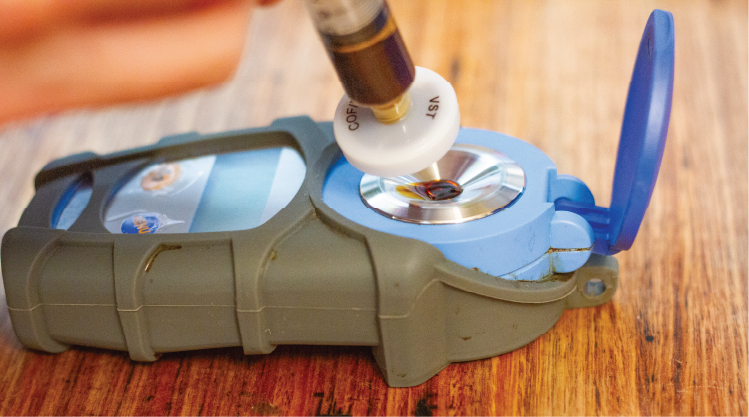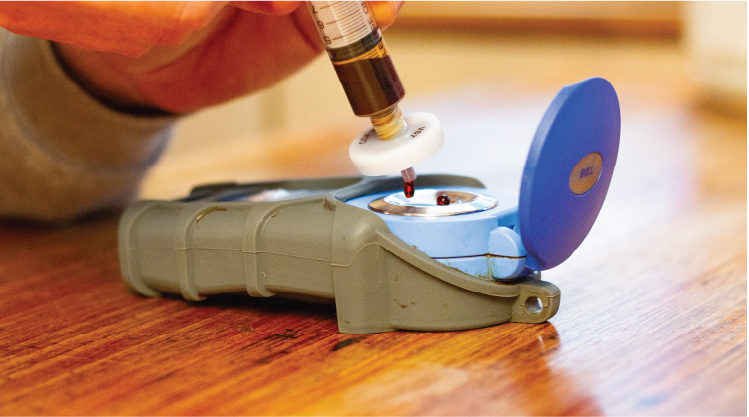
TDS and Extraction Percentage
Brewing coffee is all about flavour. The best specialty coffee in the world can be ruined if brewed badly. But by using tools like refractometers and ideas like brew ratio and extraction percentage, we can improve the extraction process and give you a good cup of coffee.
Numbers and figures will not tell you what a coffee tastes like. But they can help to figure out what you’re doing, where you’re heading and communicating ideas for brewing.
In the world of coffee brewing numbers, there are two very important ones: Total Dissolved Solids (TDS) and Extraction percentage (E).
In this article, we will look at what they are, what they mean for taste, and how you can affect them in your coffee brewing. To find the Extraction Percentage, you need to know the TDS and for that, you will need a refractometer.
A refractometer is a tool used to measure the percentage of dissolved solids compared to water. We add a sample of brewed coffee to the refractometer, and it gives us a number that tells us the brew strength. That is your TDS.
If you want to know about them, check out these in-depth videos:
Extract Everything 006: Coffee Refractometer Basics | Measuring TDS + Extraction Percentage
ULTIMATE COFFEE REFRACTOMETER SHOWDOWN (Plus Methodology and Best Practices)
Total Dissolved Solids (TDS)
When we talk about strength in coffee, we are talking about Total Dissolved Solids.
Important note: We are not talking about what the customer means when they say they want a strong coffee. They are often referring to a darker roasted coffee that with its bitter, full-bodied profile can taste ‘strong’. But what we (and the Specialty Coffee Association) mean when we talk about coffee strength is the TDS.

TDS is the amount of solubles that have been drawn from the dry coffee (dose) into the brew (yield). This number is measured as a percentage of the brew. Easy, let’s move on… just kidding.
To help us understand, we’ll run through finding the TDS of an espresso brew.
Say we’re dialling a new roast date of a blend and we want to have a similar strength to the last date for consistency in our coffees.
Our last date on the blend was tasting superb at a ratio of 21g (dose) : 42g (yield), or 1:2 ratio, and at a TDS of 9.50%. We pull a shot of the new date using the same ratio, put a sample into the refractometer and it gives us a reading of 9.51%. This means that of our yield (42g) 9.51% is dissolved solids. Therefore, we have 3.99g (42g x 0.0951) of coffee solubles and 38.01g of water in our cup. If we took a sample of the last date, it would be 3.99g (42g x 0.095). It’s the same.
It makes sense that the more coffee solids in the cup compared to water, the stronger tasting the espresso is. Since the results for the two dates are almost identical, the difference in strength will be imperceptible. This will also work if you want to change to another blend or even a Single Origin if you want all your coffees to have the same strength. Consistency is key when making coffee, so this information helps a lot.
The dose is the only place that dissolved coffee comes from. So let’s get into Extraction Percentage.
Extraction Percentage (E)
To find the Extraction Percentage you can use a coffee specific extraction app. These cost money and are not essential but can help you visualise the information. For this example we’ll do the maths (don’t worry it’s not super hard and we already did half of it above).
To find out the E we use this equation:
Yield x TDS / Dose × 100% = Extraction Percentage (E)
We’ll continue with the example we used for TDS above to explain how we find E. We have everything we need to put into the equation. So our equation will look like this:42g x 0.0951 / 21g × 100% = 3.99g / 21g × 100% = 19.02%
Note: you can make the maths a little simpler by having your TDS as 9.51 and not multiplying by 100. The reason it’s kept in this example is to show that the numerator comes from the TDS equation. We’ll make it easy now.
Now we know what percentage of coffee was extracted from the dose. What does that mean for how our coffee tastes?
Because coffee solubles extract at different rates, we can use this info to analyse a brew. Lower extraction percentages will have “brighter” flavours such as citrus, tea, or floral. As more is extracted and the percentage increases, “deeper” flavours like caramels, chocolates or even woods become present, all depending on the coffee. By having these numbers, we can understand how the changes made to the brewing process affect our cup.

Dose
We’ll start by looking at the dose because it’s often misunderstood. Looking at the equation above, we can notice the dose has an inverse relationship to the Extraction Percentage. If you increase your dose to 22g, you will get more coffee in your yield (let’s say 4.1g as a guess) but it will be a smaller proportion in relation to the dose:
42g × 9.76 / 22g = 410 / 22g = 18.64%
The coffee will taste brighter and could taste sour. This could be good if your coffee is tasting bitter/ashy, as you won’t reach the point where you are extracting these undesirable flavours. Assuming you have kept the yield the same, you notice the TDS has now increased. So you have a stronger cup, which you would expect adding more coffee, but the flavour has changed.
Yield
Yield can be a little easier to understand, increase the yield and you increase E. This will have the effect of decreasing TDS a little (if you keep the dose at 21g where we began) but overall E will increase. The equation as a result could look like this:
45g × 9.2 / 21g = 414 / 21g = 19.71%
So you may have a weaker cup, but you will have “deeper” flavours drawn out of the grounds.
Grind and Time
We’ve covered the three parameters in the E equation, but there is one thing that will have a big impact that isn’t referred to in the equation, and that’s the grind. With grind you can keep your dose and yield the same but increase the TDS.
This happens for two reasons. When you decrease the size of the coffee particles, there is more surface area for the brew water to contact and extract solubles. Smaller particles mean the puck of coffee in the basket is more compact, so the water takes longer to pass through, increasing contact time. This has the opposite effect when you make the grind more coarse.
Going back to our first E equation, you could have a result like this when making the grind finer:
42g × 10.00 / 21g = 420 / 21g = 20.00%
Note: these equations aren’t taken from real experiments, so while the effects are correct, the degree to which they will impact the brew may not be the same. Do your own experiments to find out what is happening on your setup.
Baristas already manipulate grind size and brew time by adjusting the grinder each day. The size of the coffee particles can affect how long the brew will take.
You only need to change the grind size a little to get big effects, so be careful.
A Tip for Consistency (The Power of the Equation!)
When we make espresso coffee, especially when we are making beverages with milk, we want strength to be consistent. We have to always be on top of our variables to keep the same levels of TDS. A good way to do this and make it simple is to keep most variables the same while adjusting some to keep flavour and strength where we want them.
One option is to lock in water temperature, brew pressure and yield. They all affect coffee extraction, but once set, your coffee machine keeps them consistent.
The variables here are dose and grind.
We know from Dose if we want to increase our extraction percentage; we drop the dose. This will drop the TDS but we can grind finer to maintain our previous TDS. As both actions increase our TDS, we change both parameters by a tiny amount. When you make adjustments, the strength of the espresso is the same and the ratio of coffee to milk is kept the same because we have locked in our yield. Now our milk coffees can be consistent in strength across different coffees and roast dates.
A Bit of Bad News
While Extraction Percentage can give us info on how the coffee tastes, it’s relative. There are lots of variables that affect coffee flavour; grinders, coffee machines, quality of the coffee beans, age of the roasted coffee, the list goes on. This means a 19.02% extraction on one set-up won’t taste the same on another. So we can’t just send our TDS and Extraction Percentage info to another café and get perfect results. We can use this information to improve the coffees on a particular set-up.
A Bit of Good News
This equation can be used for any percolation brewing process,from pour-over to batch brew to whatever! Your favourite brew method can be improved by knowing the extraction yield and how to manipulate it.
All the things we talked about above will have the same effect. Another very good advantage of using these numbers is maintaining your equipment. If you have large fluctuations in E over several coffees and you have changed no parameters, you can diagnose problems like chips in the burrs. Seriously, knowing this stuff is great.

Conclusion
Strength, flavour, consistency, and efficiency are all very important for making coffee at home or in a café. Knowing how your actions affect the first two will help you more efficiently find the recipe that gets you the results you want so you can spend more time enjoying your coffee. If you’re a café owner or barista, it will also mean you can spend less time dialling in and more time focussing on other parts of the business.
I hope from reading this you have garnered some information on coffee extraction. Even if you don’t have the equipment like a refractometer, you can use this info to guide your decision-making. Good luck with the rest of your coffee journey!
